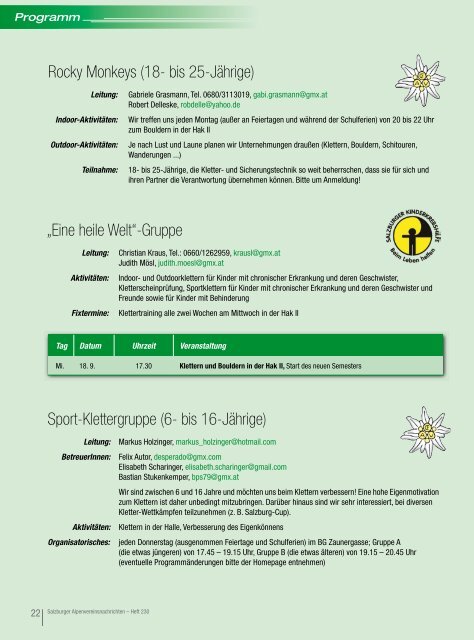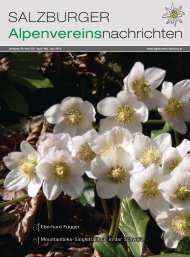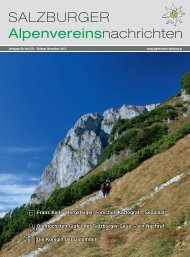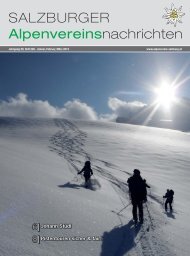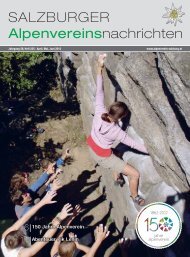230 Juli-August-September - Alpenverein Salzburg
230 Juli-August-September - Alpenverein Salzburg
230 Juli-August-September - Alpenverein Salzburg
Sie wollen auch ein ePaper? Erhöhen Sie die Reichweite Ihrer Titel.
YUMPU macht aus Druck-PDFs automatisch weboptimierte ePaper, die Google liebt.
Futures for Food - Book of AbstractsCan beans become everyday food? Attitudes to and eating of pulses among Finnishvegetarians and omnivoresNiva, Mari & Jallinoja, Piia & Järvelä, Katja & Pylvänäinen, Erja (National Consumer Research Centre, Finland) &Kotro, Jaana & Latvala, Terhi (MTT Agrifood Research Finland, Economics and Social Sciences)Due to the environmental burden caused by increasing meat and dairy consumption, consumers in the Westernworld are encouraged to substitute meat with plant-based proteins. As part of a larger research project developingbroad bean (faba bean) products, this study examines the use of and attitudes of Finnish consumers towardspulses and pulse-based foods.The data for the study were collected by an online survey in December 2012. The Internet link to the questionnairewas distributed through organisations which could reach potential pulse-users, such as animal welfare, organicfood, and student organisations, an organic food store and a vegetarian restaurant. Both users and non-users ofbeans were invited to take part in the study. The respondents (N=1186) were relatively young (mean 34.4 years;SD 12.1), a third were students and a majority were women (81.8%).As 38% of the respondents identified themselves as vegans or vegetarians, the data provide a unique opportunityfor comparison between vegetarians (incl. vegans) and omnivores. In the presentation, we compare the twogroups with respect to their 1) attitudes to and 2) use of and reasons for eating and not eating pulses. Based onthe findings we discuss the potential of plant-based proteins to become rooted in everyday life of not onlyvegetarians but also omnivores. We suggest that omnivores are generally not ready to turn into vegetarians, butthere are already signs of ‘flexitarianism’ in which pulses to some extent have replaced animal-based foods ineveryday diets.Organic vs. Intensive farming: when choosing what to buy, what is really at stake?Ferreira-Aulu, Marianna B. (University of Turku, Finland)Since the green revolution, after 1960's, intensive farming has found strong support as well as heavy opposition.Organic farmers and an increasing number of consumers avoid intensive-farmed foodstuffs. They support a moreethical way of treating animals, and food free from chemicals.But how consumers base these "ethical decisions" on? Can we really rank environment, human, and animal welfare?There is no single best farming system for all circumstances. This paper presents a comparison between intensiveand organic farming through the many spheres of sustainability.On the ethical sphere of sustainability, I look into animal well-being, by presenting the difference betweenintensive, free-range, and organic farming. On the social sphere, I look into food security and land use. Can wefeed our entire human species population with organic food? On the ecological, I look at soil organic matter,impact on biodiversity, nitrogen leaching, and energy used for production.The paper is based on several FAO reports and a meta-analysis study by Tuomisto et al (2012). In that study, 71papers with quantitative data were used to compare intensive and organic agriculture and livestock production.Tuomisto et al suggest that organic foods use less energy for production, produce a lower impact on biodiversityand have higher soil organic matter. On the other hand, organic agriculture demands considerably more land use,84% more. Intensive farming has lower nitrogen leaching per unit of area, and also lower nitrous oxide andammonia emissions. The study suggests that model studies overestimate the benefits of organic farming.The aim of my paper is to give space for fruitful discussions on food production methods, hopefully leading tocreate and inspire innovative solutions.22


